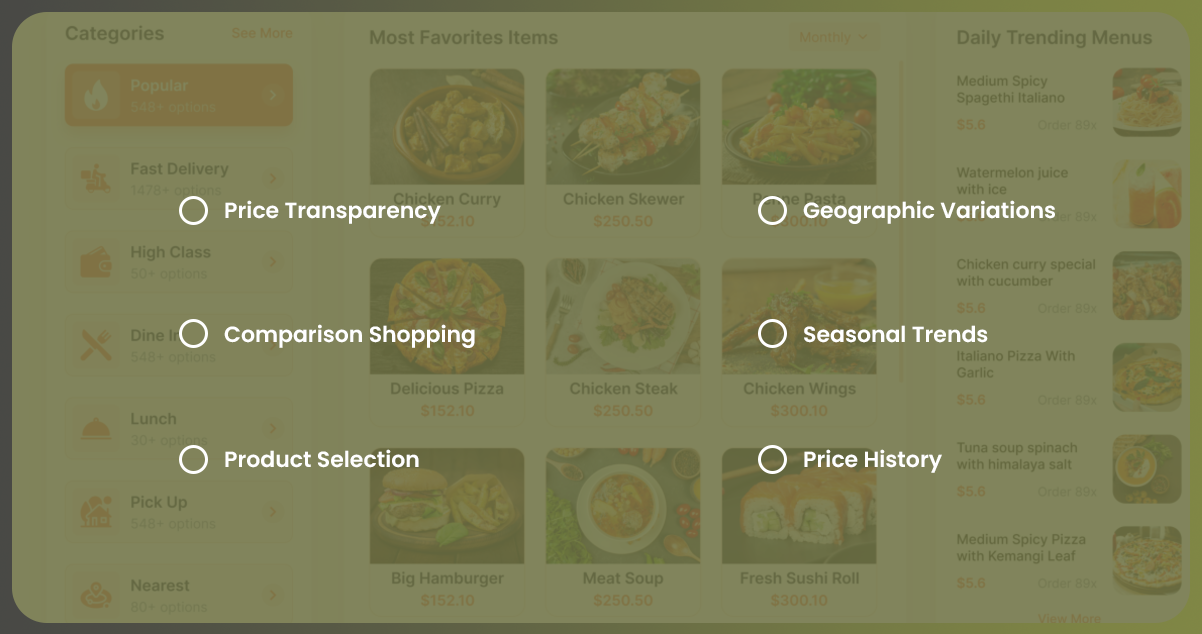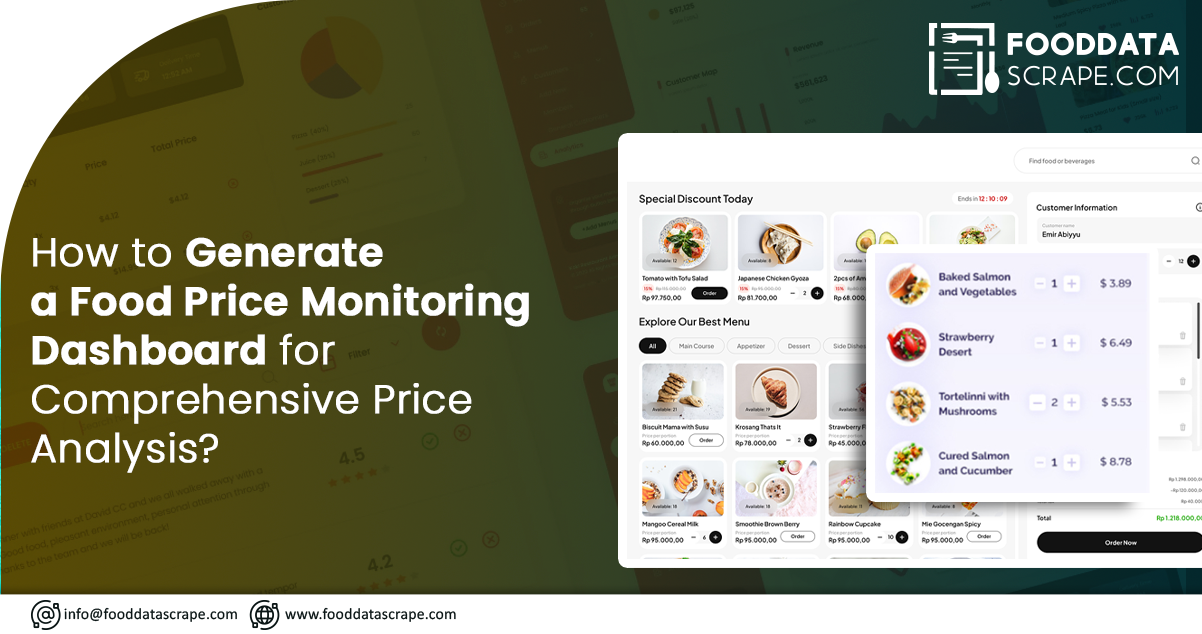Individuals, families, and businesses must monitor food prices effectively in ever-fluctuating food prices and economic uncertainty. Scrape food price data to gain insights into different pricing insights. A food price monitoring dashboard allows you to gather and analyze this data and provides a valuable solution to stay updated on the latest pricing trends. While you might think creating such a tool requires advanced coding skills, user-friendly platforms allow you to build a food price monitoring dashboard without coding knowledge. This article will guide you creating a robust and user-friendly price monitoring dashboard using low-code or no-code tools.
Unearthing meaningful insights from raw data can be a formidable challenge, mainly when dealing with extensive datasets from various sources. This challenge is especially pertinent when gathering data via web scraping. Data visualization is crucial in unraveling valuable insights from this wealth of information. Effective visualization can reveal trends and anomalies, thereby shifting through the noise in the data and highlighting the information that truly matters. Developing a price monitoring solution for small businesses with limited resources can take time and effort. However, the ability to construct a simple yet effective price monitoring dashboard using food data scraping services offers a cost-efficient alternative.
Constructing a Price Monitoring Dashboard with Scraped Data

This article will guide you through building your price monitoring dashboard by harnessing the capabilities of data visualization tools like Microsoft PowerBI, Tableau, and Google Data Studio.
Price monitoring is pivotal in understanding how your competitors price their products and where your prices stand within the industry. This practice is indispensable in maintaining pricing accuracy and staying abreast of current price dynamics and product availability.
Monitoring prices is not merely about tracking the fluctuations in the cost of goods and services; it is a strategic imperative for businesses across various sectors. Delving into its various dimensions is essential to appreciate the full scope and significance of price monitoring. This article will walk you through the critical aspects of price monitoring, exploring its importance, methodologies, and how it can help to gain a competitive edge in today's dynamic business landscape.
Understanding Food Price Monitoring
Food price monitoring is a critical practice in today's dynamic economic landscape. It involves the systematic tracking and analysis of food prices, serving as a vital tool for individuals, businesses, researchers, policymakers, and consumers. Here, we delve deeper into the significance and diverse applications of food price monitoring.
Budgeting and Household Finance
Keeping a close eye on food prices is integral to effective budgeting for individuals and families. The cost of groceries greatly influences household expenses, and when food prices fluctuate rapidly, it can challenge even the most diligent budgeting efforts. By continuously monitoring food prices, individuals can make informed decisions on where and when to shop, ensuring they get the best value for their money. This practice helps stretch their budget and secure their financial well-being.
Business Planning
In food service providers, restaurants, and retailers, tracking food prices is fundamental to business planning. The costs of ingredients and supplies directly impact profit margins and pricing strategies. By staying updated on food prices, businesses can adjust their pricing strategies, optimize costs, and remain competitive. Effective cost management, driven by price monitoring, is crucial for such enterprises' long-term sustainability and profitability.
Market Research and Policy Development
Food price data is a goldmine for researchers and policymakers. These data sets evaluate critical economic factors such as inflation rates and food security. By assessing the trends in food prices, researchers can gain insights into the economic conditions of a region or a country. Policymakers rely on this information to make informed decisions about social welfare, trade policies, and public health programs. The ability to foresee potential food price spikes or declines enables governments to implement timely interventions, ensuring the well-being of their citizens.
Consumer Empowerment
In today's information age, consumers have easy access to data. Monitoring food prices empowers consumers to make choices that align with their financial goals and preferences. Armed with price information, consumers can select the most cost-effective options, opt for alternatives when prices surge, or take advantage of discounts and promotions. It's a form of financial empowerment that translates into monetary savings and more control over personal finances.
Supply Chain Management
For businesses involved in the food industry, such as food manufacturers and distributors, understanding food price trends is essential for supply chain management. Prices of raw materials, transport, and labor prices can significantly impact the production cost. Monitoring these variables helps optimize supply chain strategies, ensuring efficiency and competitiveness. Businesses can make informed decisions about sourcing, inventory management, and pricing structures by identifying cost trends.
Food price monitoring is more than just a practice; it is a multifaceted tool that influences how individuals and organizations make decisions about their finances, business strategies, and public policies. In an era of rapid economic changes and shifting consumer demands, staying informed about food prices is a cornerstone of responsible decision-making and sound financial management.
About Food Price Monitoring Dashboard

A food price monitoring dashboard is a powerful tool that allows users to compare prices of food data based on different locations. This feature offers valuable insights into local and regional market variations, enabling consumers to make cost-effective purchasing decisions. It empowers businesses to tailor their pricing and marketing strategies to specific regions, optimizing supply chain operations for maximum efficiency. For governments and policymakers, this data is invaluable in understanding disparities in food affordability and identifying areas that may require targeted interventions to ensure food security for all. Furthermore, this capability fosters market transparency, competition, and fairness by exposing discrepancies and encouraging responsible pricing practices. In a world of diverse economic landscapes, comparing food prices based on locations is crucial for enhancing economic well-being and access to food resources across various communities and regions.
How Can Scraping Food Price Data Help in Comparing Prices?

Scraping food price data can be beneficial for comparing prices in various ways:
Price Transparency: Price scraping provides access to real-time and historical pricing information from various sources, making it easier to see the actual prices of food items in different locations and markets.
Comparison Shopping: Consumers can use scraped data to compare online and offline prices at different retailers. It empowers them to find the best deals, discounts, and promotions, ultimately saving money on their grocery bills.
Product Selection: With access to price data, consumers can make informed decisions about which specific brands or product variants offer the best value for money. It can help them choose products that meet their budgetary constraints without compromising quality.
Geographic Variations: Food prices vary by region due to transportation costs, local demand, and supply. Scraping data allows users to compare prices across different locations, helping them understand the regional disparities in food costs.
Seasonal Trends: Food prices can fluctuate with seasons and holidays. Scraped data enables consumers to track these seasonal variations, plan their purchases, and stock up on items when prices are lower.
Price History: Historical price data, often available through scraping, provides insights into price trends. This information can help consumers determine the best time to buy specific items and when to expect price increases or discounts.
To collect data from the dashboard, you can follow these steps:
- Start by accessing the dashboard section and then precisely navigate to the "Food Dashboard."
- You will get a new dashboard view upon clicking on the "Food Dashboard" option.
- You can select specific criteria for your desired data within this dashboard view. It includes choosing the desired category of food products you want to examine and the particular states or regions you wish to focus on.
- Once you've selected it, the dashboard will display your view. In this view, you will compare the average prices of the chosen food category across the selected states or regions. Each state will be accompanied by its name, allowing you to quickly assess and compare the pricing trends for the specified food items in your chosen locations. This information can be invaluable for making informed decisions about food prices, market trends, and regional disparities.
For in-depth information, please feel free to contact Food Data Scrape. We serve as your all-in-one solution for Food Data Aggregator and Mobile Restaurant App Scraping services. Our cutting-edge insights and analytics empower well-informed decision-making, taking your business strategies to the next level. Don't hesitate to contact us today for success driven by data!
Get in touch
Get in touchWe will Catch You as early as we recevie the massage
Trusted by the best of the food industry

























































































